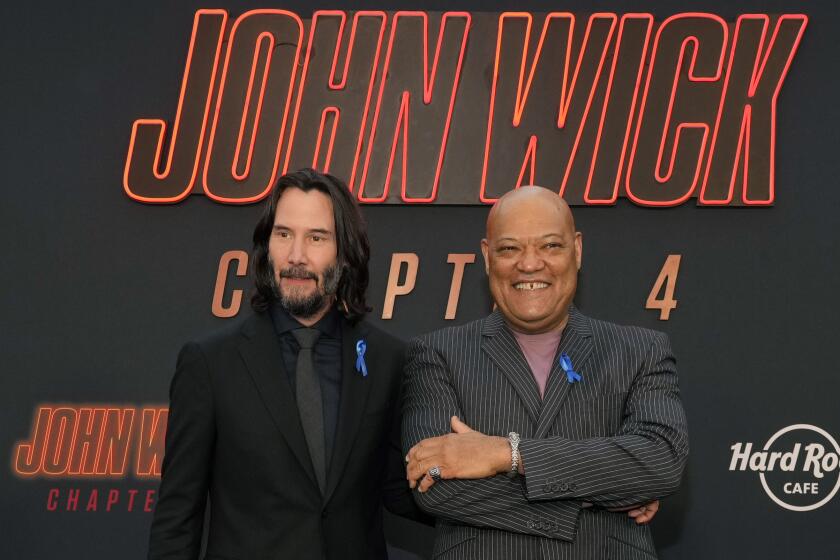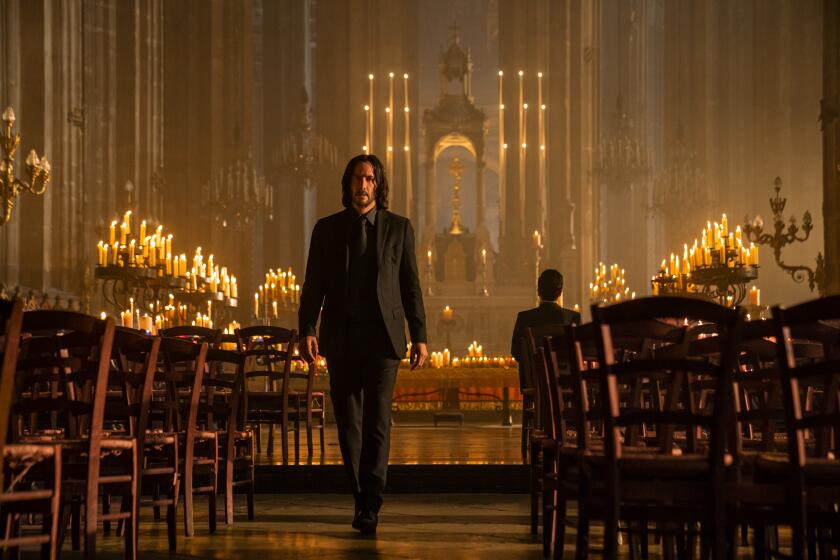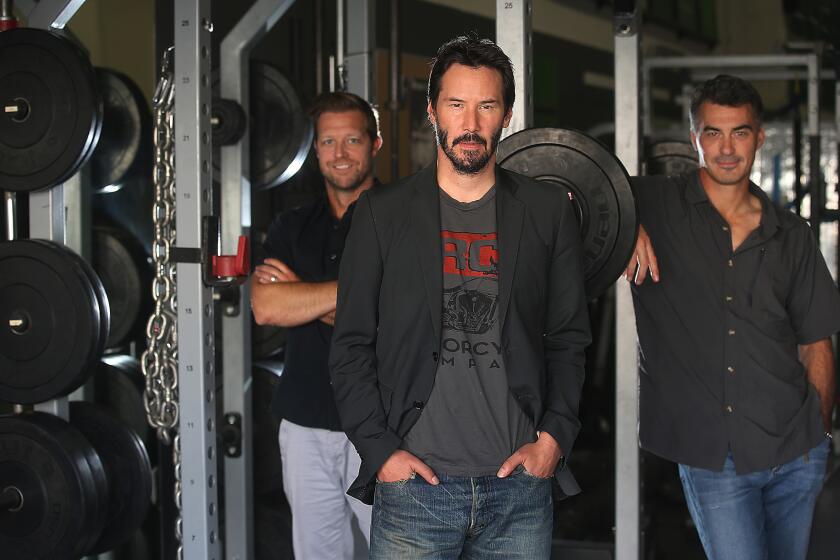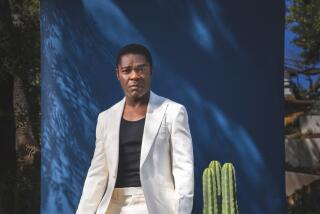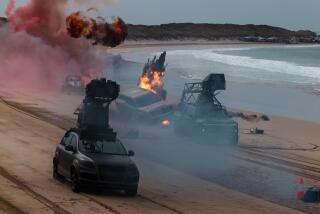How Keanu Reeves’ stunt double became ‘John Wick’s’ action auteur
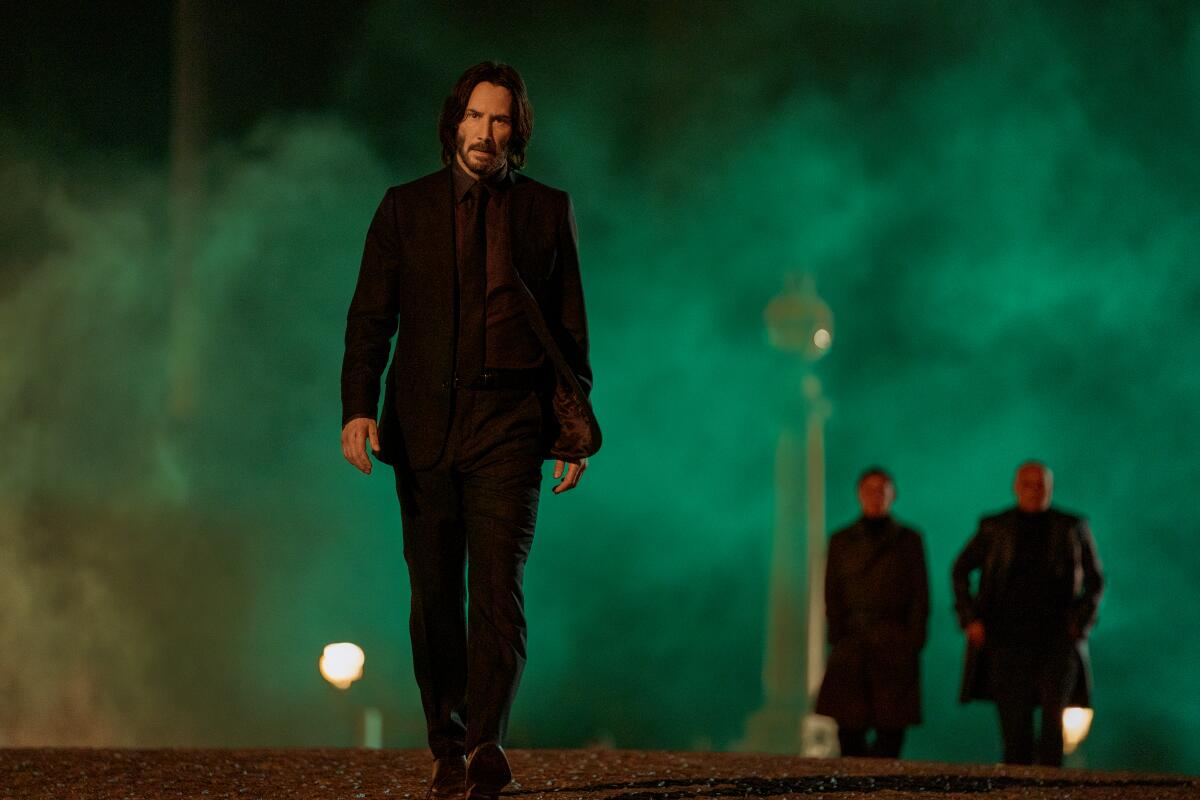
- Share via
For four films and counting, Keanu Reeves has fought, shot and slashed his way to hell and back again as tormented hit man John Wick, a boogeyman with a sky-high body count and a soft spot for puppies in an underworld of killers.
And for nearly 10 years, the man behind Reeves building the bespoke world of “John Wick” has been Chad Stahelski, his longtime stunt double, who co-directed the 2014 original with David Leitch before solo-helming sequels “John Wick: Chapter 2” (2017), “John Wick: Chapter 3 — Parabellum” (2019) and “John Wick: Chapter 4,” out Friday.
For Stahelski, now one of Hollywood’s top action directors, it’s been a decade spent not just carving out a stylish new era in American action cinema, but also establishing his own creative voice. “I’ve used the ‘John Wicks’ as a comfort zone to really explore who I am,” Stahelski told The Times. “The first two movies are love letters. The third one is the first time I asked, ‘What’s me?’ And the fourth is probably the closest I’ve gotten so far.”
‘John Wick 4’ stars Donnie Yen, Hiroyuki Sanada and pop star Rina Sawayama bring franchise-best action to Keanu Reeves’ hit-man series.
In “John Wick 4,” Stahelski deepens the bench with a murderer’s row of action stars (Donnie Yen, Hiroyuki Sanada, Scott Adkins, Marko Zaror), genre favorites (Bill Skarsgård, Clancy Brown), familiar faces (Ian McShane, Lance Reddick) and new blood (Shamier Anderson, musician Rina Sawayama) as Reeves’ titular assassin treks the globe to end his quest against the secretive High Table.
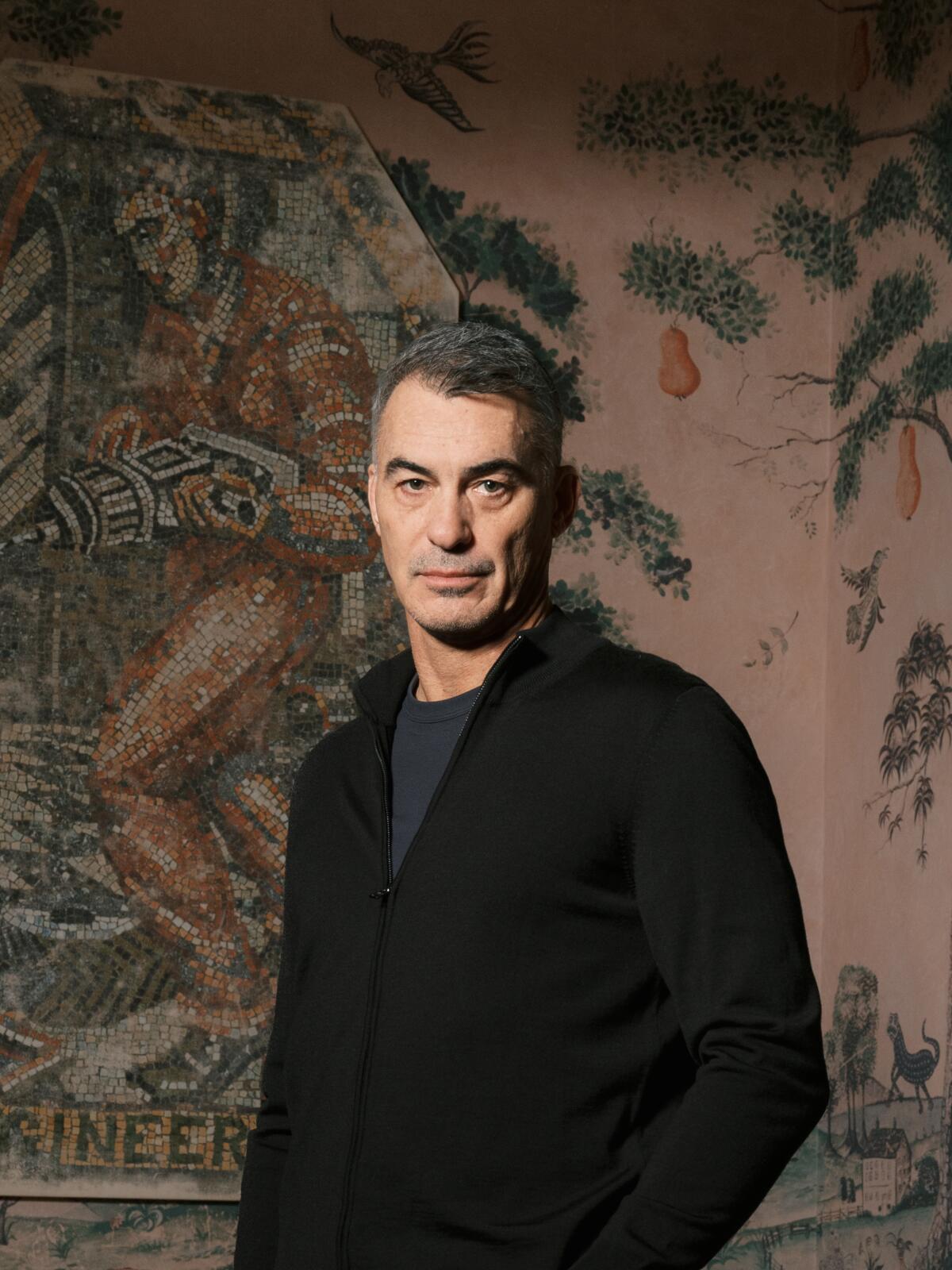
With each installment, Stahelski has scaled the action up to more operatic and physically demanding heights, and his “John Wick 4” scenes in particular are exquisitely wrought spectacles of carnage turned all the way up to 11. A breathtaking God’s-eye view as Wick mows his way through an enemy-infested house. The resourceful killer double-fisting guns and nunchaku amid antique samurai weapons encased in glass. A wrong-way speeding gunfight around the Arc de Triomphe. And a seriously long staircase with a loony payoff leading to the Sacré Coeur Basilica at dawn.
Keanu Reeves remembers his co-star Lance Reddick on the red carpet at the ‘John Wick 4’ premiere in Los Angeles: ‘Lance was a beautiful person.’
At a nearly three-hour running time, “John Wick 4” boasts four times more action than the previous entries while further synthesizing the inspirations already woven into the modern antihero saga’s DNA: Sergio Leone westerns, samurai tales, film noir, Joseph Campbell myth-making.
Yet Stahelski, 54, is loathe to call himself an artist. A dedicated craftsman, to be sure, but artist? That’s a title reserved for Steven Spielberg or Leonardo da Vinci, he says. After leveling up and learning by working for genre legends like Yuen Woo-ping and Lana and Lily Wachowski, he still sees himself working to earn his right to the word.
“I know where to put a camera. I’m very good at editing, and I can see things in my head,” he muses over breakfast at Culina in Beverly Hills the morning after finishing three years of work on the film as both director and producer. “I give you a blank piece of paper and go, ‘Give me a great idea.’ Not a lot of people can fill that page up. It’s not remaking ‘Batman’; it’s the one that came up with ‘Batman.’ The imagination, the spark, the idea — that’s artistry.”
Keanu Reeves returns as a reluctant assassin in the globe-trotting ‘John Wick: Chapter 4,’ the latest entry in director Chad Stahelski’s action franchise.
That spark is what Stahelski is chasing even as “John Wick 4” is set to open to the best reviews of the franchise. He’s quick to exalt with rapid-fire passion the works that inspire him, such as influential anime “Ninja Scroll,” the Lee Marvin classic “Point Blank,” his favorite novel “Shibumi” by Trevanian, the James Bond movies he grew up watching and the works of Zhang Yimou, Wong Kar-wai and Akira Kurosawa.
Confident and unshowy, Stahelski speaks with a self-described brutal honesty borne of decades in the stunt world, where straight talk is a necessity of the job. But Reeves, also an executive producer on “John Wick 4,” describes the poetry in the director’s meticulous approach to everything he puts onto the screen, especially in a fourquel that brings some finality to the gentleman killer’s story.
“Inside the craft is a philosophy, an existentialism. You can talk about it, or you can have a wide shot of a guy staring out into space with a tree next to him, in nature,” said Reeves. “Every color, every suit, his relationship with [cinematographer] Dan Laustsen, it’s all personal. I can’t unpack or take apart the tapestry and pick a thread. All of the threads lead to Chad.”
I can’t unpack or take apart the tapestry and pick a thread. All of the threads lead to Chad.
— “John Wick” star Keanu Reeves
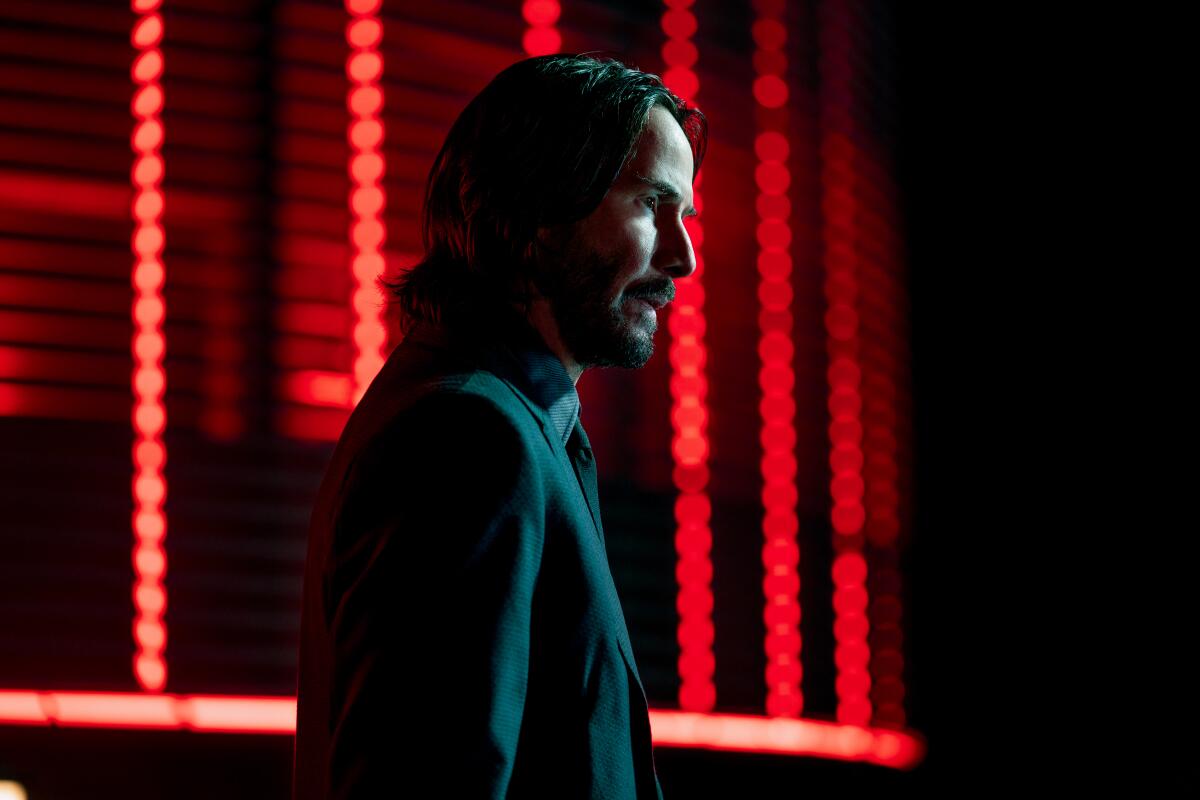
Stahelski credits that ethos to the “Wachowski school of filmmaking,” a modus operandi applicable to artists and assassins alike that inspired a line in “John Wick 4”: “How you do anything is how you do everything.” It’s why he worked with costume designer Paco Delgado to inlay gleaming silver thread into the suits worn by Skarsgård’s villainous Marquis so the camera catches every move, or how years of living out of a suitcase as a working stuntman informed the etiquette of the Continental hotels that cater to elite killers in the films.
It’s bled into how he exists even off the clock, watching strangers interact in the real world, or noting how light reflects off a puddle on a highway — all fuel for a story he might tell one day. Then again, he owes his career to the obsessions that enraptured him as a child growing up in Palmer, Mass., where his curiosity for martial arts began with Bruce Lee movies and in the pages of Black Belt magazine, the nearby woods a breeding ground for his imagination.
“You rode your bicycle, went to the woods and you had a stick,” Stahelski said with a smile. “That stick was your M-16, your sword, your fire hose, a rocket ship, whatever you needed it to be.” Through his father’s friend, he started learning judo, then karate and jujitsu, competing in his teens and becoming immersed in the world of martial arts.
Attending USC because of its proximity to Dan Inosanto’s famed martial arts academy in Marina del Rey, he found himself training with legends at 17 and meeting Brandon Lee, whom he doubled on “The Crow.” Some of his first breaks came in the early ‘90s from genre auteur Albert Pyun, who put him in B-movies like “Brainsmasher: A Love Story” and “Nemesis 2: Nebula.” (That’s also him with a long braid, fighting Daniel Bernhardt in the Kumite, in “Bloodsport 2.”)
“Albert took me under his wing and had me play small parts and learn how to do stunts. That led to everything,” Stahelski said of the late filmmaker, who died last year. “I was traveling to the Philippines, to Hong Kong, all over the United States ... in my downtime I did gymnastics, learned how to rock climb, drove cars. I was like, ‘This is the greatest job. All I have to do is risk my life? I’m in.’”

Soon he’d carved out a career in stunts, a lanky 6-foot-1 fighter who could do the splits and backflip on command — so much so he almost missed the opportunity of a lifetime, turning down work on “The Matrix” because he had a steady gig on NBC’s “The Pretender.” Luckily he’d aced the grueling audition, put through tumbling runs, fight choreography, staff and wire work by Hong Kong master Yuen and his team. After production delays, he got another chance and took it, becoming Reeves’ Neo double and later stunt coordinator on the sequels.
By the time Reeves was mulling the indie neo-noir thriller that would become 2014’s “John Wick,” he knew what Stahelski and fellow stunt veteran Leitch, who opened action design company 87Eleven together in 1997, could do as second-unit directors on studio action pics. He sent them the script by Derek Kolstad, and they won the job as first-time directors. (Leitch went on to direct “Atomic Blonde,” remaining an executive producer on the “Wick” sequels.)
“John Wick 4,” written by Shay Hatten and Michael Finch, finds Stahelski and Reeves’ collaboration in full bloom, aligned in their vision for everyone’s favorite un-retired hit man. It also prompted them to search deeply within for meaning, to not rush to churn out more sequels. “I think every time you write something you take a break, you see things and you think — you live — and the living is what gives you the inspiration,” said Stahelski.
Landing on a fourth chapter that felt both organic and earned, they gravitated to themes around death, purpose and peace. “Chad introduced the Japanese ideas of hagakure, bushido and honor — a way to die, a good death,” said Reeves. “Chad likes to make John suffer, which I really appreciate. [Through] John’s grief, struggle and his search for personal freedom, he keeps going, a force of will. But Chad likes to f—’ knock John down and see him get back up.”
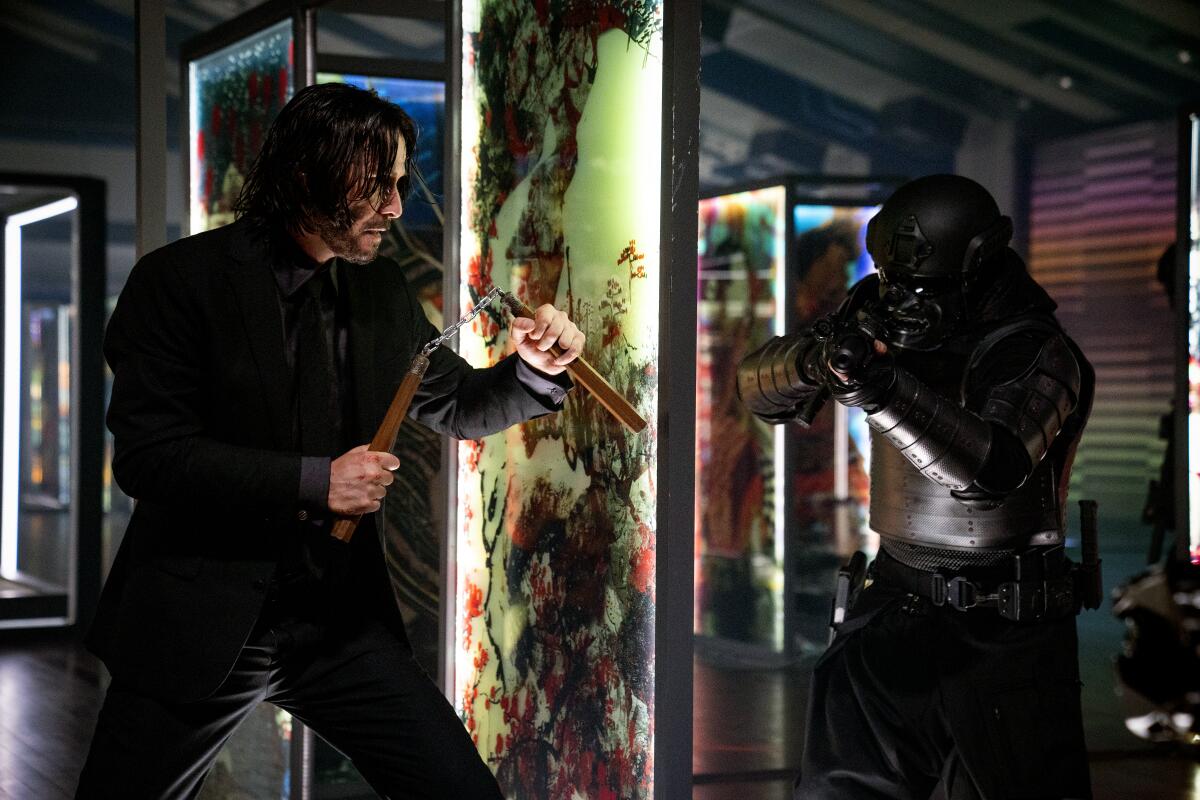
Yet even as he demands more from the Wick onscreen, Stahelski knows the limitations of the human body. Putting his underworld Odysseus through escalating set pieces meant asking more of Reeves, who at 58 sells the wear and tear acutely well. “Look: you can’t fight Father Time,” said Stahelski, who still teaches regularly at 87Eleven. “Even if it was three action sequences for each movie, you’d be asking more just to maintain.”
Reeves trained nine months out in various skill sets to prepare for the shoot’s 14 set pieces and is a movie star uniquely adept at certain stunts, Stahelski beams — but performing them under pressure adds extra risk factors. That’s where the bond between the two factored in, Stahelski trusting that Reeves could execute moves requiring extreme cool under pressure and the star trusting his director and international stunt teams, under coordinator Scott Rogers, to keep him safe.
“He could do a 360. He could drift the car one-handed and shoot the gun, which not a lot of stunt guys can do. But now I’m asking him to do it with 30 other cars coming head-on,” said Stahelski of the Arc de Triomphe sequence. “When he’s driving through traffic, weaving in and out and throwing the 180, you’re praying to the movie gods, ‘Let this be a good day.’”
If Stahelski’s canvases are $100-million studio movies with 400 cast and crew members, the highly trained stunt pros of 87Eleven are his lethally precise paintbrushes. He proudly describes them akin to a ballet company dancing “Swan Lake,” each performer trained to know every movement, beat and role inside and out. “We are 98% more like dancers than we are martial artists,” he said.
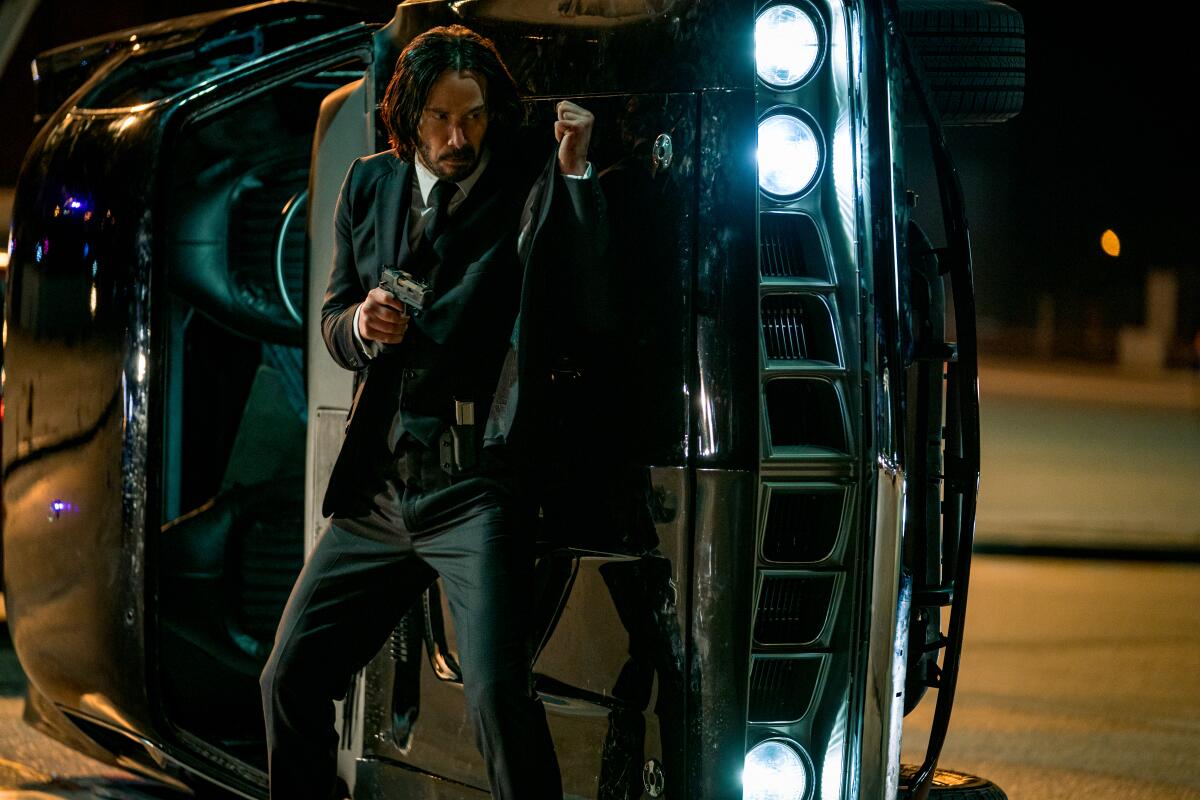
If you’ve ever watched some chiseled action hero coolly taking out bad guys onscreen and thought to yourself, “How hard could that be?”
Does that make him, say, the Bob Fosse of action cinema? “If that was the title on my tombstone, I could do much worse,” said Stahelski, laughing at the comparison to another of his favorite artists. “No, I don’t think I’m that clever. To take different styles of dance and to conform them to his own, that’s artistry. I try to steal from the best and see what I can put my spin on. But to develop something from scratch? That’s genius.”
Giving John Wick some well-earned rest — for now, at least — should free Stahelski up to stretch his storytelling wings, even as the hit franchise continues to expand. He’s attached to several non-”Wick” features and is an executive producer on the upcoming Ana de Armas-starring “Ballerina,” set within the world of “Wick,” and Peacock’s “Continental” 1970s-era prequel series. But is “Chapter 4” where John Wick’s story ends?
The greatest gift you can give an audience is the hunger for more, Stahelski answered, referencing a character last seen in “Chapter 2.” “Let’s look at Common. I’d suspect that you’d see Cassian again if we ever did a satellite project or a true ‘John Wick’ TV show,” he teased. The future of John Wick on film might be officially yet-unwritten, but Stahelski relishes how fan imaginations run wild with theories he might one day fold into the canon.
“It’s like, can you ever get enough of Jackie Chan? I’ve watched all 26 ‘Zatoichis’ — did I get enough? No!” he grinned. “You fill in the gaps in your own head: ‘Wouldn’t it be cool if...’ And to leave people with things like that, I think, is the best way to do it.”
More to Read
Only good movies
Get the Indie Focus newsletter, Mark Olsen's weekly guide to the world of cinema.
You may occasionally receive promotional content from the Los Angeles Times.

